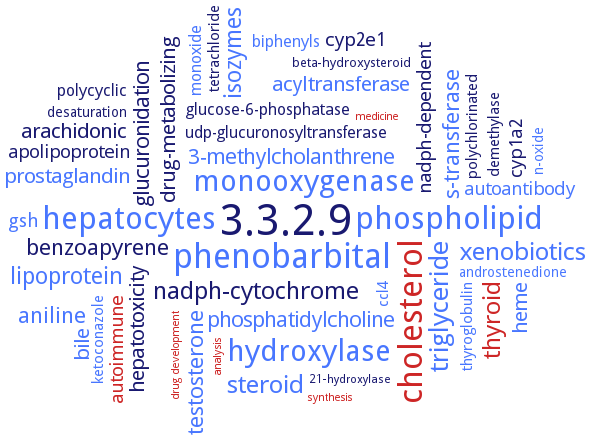3.3.2.9: microsomal epoxide hydrolase
This is an abbreviated version!
For detailed information about microsomal epoxide hydrolase, go to the full flat file.

Word Map on EC 3.3.2.9 
-
3.3.2.9
-
phenobarbital
-
cholesterol
-
phospholipid
-
hepatocytes
-
monooxygenase
-
hydroxylase
-
triglyceride
-
xenobiotics
-
steroid
-
nadph-cytochrome
-
thyroid
-
isozymes
-
lipoprotein
-
s-transferase
-
testosterone
-
aniline
-
benzoapyrene
-
phosphatidylcholine
-
glucuronidation
-
3-methylcholanthrene
-
bile
-
drug-metabolizing
-
arachidonic
-
prostaglandin
-
acyltransferase
-
heme
-
hepatotoxicity
-
nadph-dependent
-
cyp2e1
-
gsh
-
autoimmune
-
apolipoprotein
-
cyp1a2
-
autoantibody
-
biphenyls
-
polycyclic
-
udp-glucuronosyltransferase
-
monoxide
-
glucose-6-phosphatase
-
tetrachloride
-
polychlorinated
-
thyroglobulin
-
ketoconazole
-
demethylase
-
ccl4
-
desaturation
-
n-oxide
-
androstenedione
-
beta-hydroxysteroid
-
21-hydroxylase
-
synthesis
-
medicine
-
drug development
-
analysis
- 3.3.2.9
- phenobarbital
- cholesterol
- phospholipid
- hepatocytes
- monooxygenase
- hydroxylase
- triglyceride
- xenobiotics
- steroid
-
nadph-cytochrome
- thyroid
- isozymes
- lipoprotein
- s-transferase
- testosterone
- aniline
-
benzoapyrene
- phosphatidylcholine
-
glucuronidation
- 3-methylcholanthrene
- bile
-
drug-metabolizing
-
arachidonic
- prostaglandin
- acyltransferase
- heme
-
hepatotoxicity
-
nadph-dependent
- cyp2e1
- gsh
- autoimmune
-
apolipoprotein
- cyp1a2
- autoantibody
- biphenyls
-
polycyclic
-
udp-glucuronosyltransferase
- monoxide
- glucose-6-phosphatase
-
tetrachloride
-
polychlorinated
- thyroglobulin
- ketoconazole
- demethylase
- ccl4
-
desaturation
- n-oxide
- androstenedione
-
beta-hydroxysteroid
- 21-hydroxylase
- synthesis
- medicine
- drug development
- analysis
Reaction
Synonyms
alpha,beta fold epoxide hydrolase, alpha,beta-fold type EH, E1-b', EC 3.3.2.3, EC 4.2.1.63, EC 4.2.1.64, EH1, EH2, Eha, EHb, EPHX, EPHX 1, EPHX1, EPOX, epoxide hydrolase, HYL1, JH epoxide hydrolase, JHEH, juvenile hormone epoxide hydrolase, mEH, mEH-like protein, mEH1, mEPHX, microsomal, microsomal EH, microsomal EPHX1, Microsomal epoxide hydrolase, microsomal epoxide hydrolase 1, microsomal epoxide hydrolase-like protein, microsomal xenobiotic epoxide hydrolase, More, PNSO hydrolase, SEH, styrene-epoxide hydrolase, Tcjheh-r1, Tcjheh-r3, XEHase, xenobiotic epoxide hydrolase


 results (
results ( results (
results ( top
top





